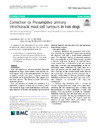Identificador persistente para citar o vincular este elemento:
https://accedacris.ulpgc.es/jspui/handle/10553/106720
| Campo DC | Valor | idioma |
|---|---|---|
| dc.contributor.author | Cartagena-Albertus, Juan Carlos | en_US |
| dc.contributor.author | Moise, Antoaneta | en_US |
| dc.contributor.author | Moya-García, Sergio | en_US |
| dc.contributor.author | Cámara-Fernández, Nora | en_US |
| dc.contributor.author | Montoya Alonso, José Alberto | en_US |
| dc.date.accessioned | 2021-04-12T12:43:13Z | - |
| dc.date.available | 2021-04-12T12:43:13Z | - |
| dc.date.issued | 2021 | en_US |
| dc.identifier.issn | 1746-6148 | en_US |
| dc.identifier.other | Scopus | - |
| dc.identifier.uri | https://accedacris.ulpgc.es/handle/10553/106720 | - |
| dc.description.abstract | In response to the publication of the article, readers brought to the author’s attention that there are some inaccuracies in the original published article [1]. 1. In the abstract, it is stipulated that thoracic metastasis of mast cell tumours (MCT) has not been reported in dogs, however this is inaccurate and therefore the abstract should be amended to the following: Abstract Background Mast cell tumours are the most common cutaneous neoplasms in dogs. Other primary sites include visceral organs, such as the gastrointestinal tract, liver, or spleen, and the oral cavity. Frequent metastatic sites include the local lymph nodes, skin, spleen, liver and bone marrow. The thorax is rarely affected by metastatic disease. Mast cell tumours are usually not considered as a differential diagnosis for lung and intrathoracic chest wall masses in dogs. Chest wall tumours can be primary tumours of the ribs and sternum, an invasion of adjacent tumours into the chest wall, and metastasis from distant tumours. | en_US |
| dc.language | eng | en_US |
| dc.relation.ispartof | BMC Veterinary Research | en_US |
| dc.source | BMC Veterinary Research [EISSN 1746-6148], v. 17 (1), 142, (Diciembre 2021) | en_US |
| dc.subject | 310907 Patología | en_US |
| dc.title | Correction to: Presumptive primary intrathoracic mast cell tumours in two dogs (BMC Veterinary Research, (2019), 15, 1, (204), 10.1186/s12917-019-1950-5) | en_US |
| dc.type | info:eu-repo/semantics/Article | en_US |
| dc.type | Article | en_US |
| dc.identifier.doi | 10.1186/s12917-021-02852-7 | en_US |
| dc.identifier.scopus | 85103380152 | - |
| dc.contributor.authorscopusid | 57202737831 | - |
| dc.contributor.authorscopusid | 57202627600 | - |
| dc.contributor.authorscopusid | 57202750027 | - |
| dc.contributor.authorscopusid | 57209339752 | - |
| dc.contributor.authorscopusid | 6504331949 | - |
| dc.identifier.eissn | 1746-6148 | - |
| dc.identifier.issue | 1 | - |
| dc.relation.volume | 17 | en_US |
| dc.investigacion | Ciencias de la Salud | en_US |
| dc.type2 | Artículo | en_US |
| dc.utils.revision | Sí | en_US |
| dc.date.coverdate | Diciembre 2021 | en_US |
| dc.identifier.ulpgc | Sí | en_US |
| dc.contributor.buulpgc | BU-VET | en_US |
| dc.description.sjr | 0,65 | |
| dc.description.jcr | 2,792 | |
| dc.description.sjrq | Q1 | |
| dc.description.jcrq | Q1 | |
| dc.description.scie | SCIE | |
| dc.description.miaricds | 10,7 | |
| item.grantfulltext | open | - |
| item.fulltext | Con texto completo | - |
| crisitem.author.dept | GIR IUIBS: Medicina Veterinaria e Investigación Terapéutica | - |
| crisitem.author.dept | IU de Investigaciones Biomédicas y Sanitarias | - |
| crisitem.author.dept | Departamento de Patología Animal, Producción Animal, Bromatología y Tecnología de Los Alimentos | - |
| crisitem.author.orcid | 0000-0002-2683-7592 | - |
| crisitem.author.parentorg | IU de Investigaciones Biomédicas y Sanitarias | - |
| crisitem.author.fullName | Montoya Alonso, José Alberto | - |
| Colección: | Artículos | |
Citas de WEB OF SCIENCETM
Citations
1
actualizado el 08-jun-2025
Visitas
80
actualizado el 15-jun-2024
Descargas
59
actualizado el 15-jun-2024
Google ScholarTM
Verifica
Altmetric
Comparte
Exporta metadatos
Los elementos en ULPGC accedaCRIS están protegidos por derechos de autor con todos los derechos reservados, a menos que se indique lo contrario.
